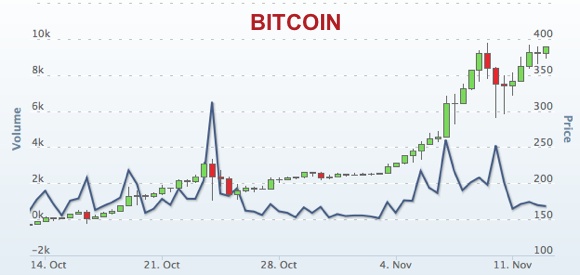Bitcoin – The New Gold or just another Bubble?
Dec 3, 2013 at 2:48 pm in Fundamental Analysis by Dave
When Bitcoin was created in 2008, we suspect very few people would have imagined just how serious the project would become. At first it was simply an elegant computer code set up to serve the interests of just a few computer geeks. The virtual currency then took on a life of its own, growing to the point of being an actual means of exchange to buy real assets such as pizza, technology and even casino chips (irony of ironies!). People started trading the Bitcoin in exchanges that popped up around the globe. Not surprisingly, all this increase in popularity brought a great deal of extra attention, but this time from both Central Banks and governments. At first, the US Government dismissed the Bitcoin as just another silly fad but, as its popularity grows by the day, the authorities are focusing in upon potentially regulating this bastion of free currency expression.
Of course, the basic premise for regulation is that they are looking out for the usual money laundering and illegal activities. By highlighting the risks of the digital currency and attaching it to an illegal field, the US Govt hopes it can hide the real threat behind the Bitcoin. Bitcoin is becoming an expression against unsound Government and Central Bank policies aimed at enriching the few while stealing from the many…
The Bitcoin was, of course, created by the mysterious and unknown figure known only as Satoshi Sakamoto, and with a very simple idea behind it. Sakamoto wanted a new currency, entirely independent from governments, which would put the creation of money in the hands of people and, importantly, be limited in its supply. This is the central idea behind Austrian economics. Austrian economists believe that unmanaged money supply eventually leads to better-formed investment decisions and to real wealth generation. Central banks cease to exist, meaning no one can control the money supply.
When it was traded for the first time, one Bitcoin was worth just 10 cents of the dollar. But as it grew in popularity, its price relative to the dollar also rose. In February 2011 it was already trading at parity. With central banks around the world engaging in devaluation policies with their massive money printing, the Bitcoin has continued its seemingly unstoppable rise, in fact just recently, at the time of writing, reaching the heady heights of $400 for one Bitcoin!
At this point, it is embarrassing for the US Government to let the Bitcoin continue to trade higher and higher against the dollar as it raises many issues…
First of all, why is Bitcoin rising so much while gold is unaffected by money printing? With both the supply of gold and Bitcoin relatively stable, they should be moving in tandem against the dollar. The Bitcoin rise just highlights what many have advanced. The gold market is being manipulated.
Second, the US Government is losing potential tax revenue, just like it was with online gambling a few years ago. If there’s a large market, they want to be part of it. First they rule it as illegal. Then, in the tried and tested form, they regulate and tax it.
Third, the Bitcoin threatens central banks as it is a substitute for fiat currencies. If people perceive the Bitcoin as a serious project, they will exchange their dollars for the Bitcoin as long as the wanton printing continues, just like they did during the gold standard whenever the Government tried to accelerate money creation.
Just a few days ago, Raoul Pal, head of Global Macro Investor, made a bold Buy recommendation on the Bitcoin. He analysed the Bitcoin in terms of demand and supply and came to the conclusion that 1 Bitcoin should be equivalent to 700 ounces of gold when one equates the underlying supply dynamics of each. That means the correct price for the Bitcoin would be $1,000,000! That’s right, one and six figures! Is he right? As ever, only time will be the ultimate arbiter…
Article reproduced from the January edition of Spread Betting eMagazine


